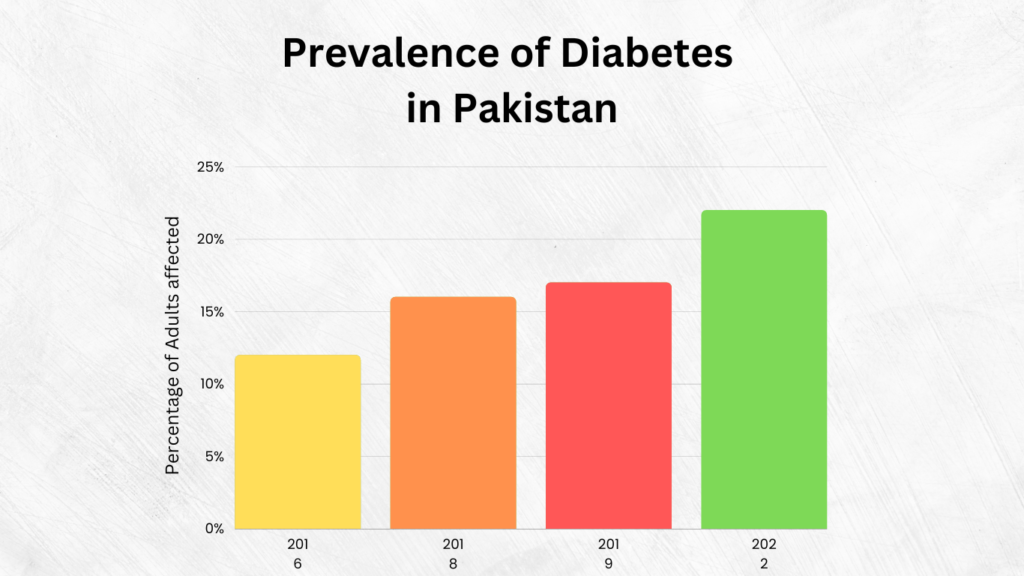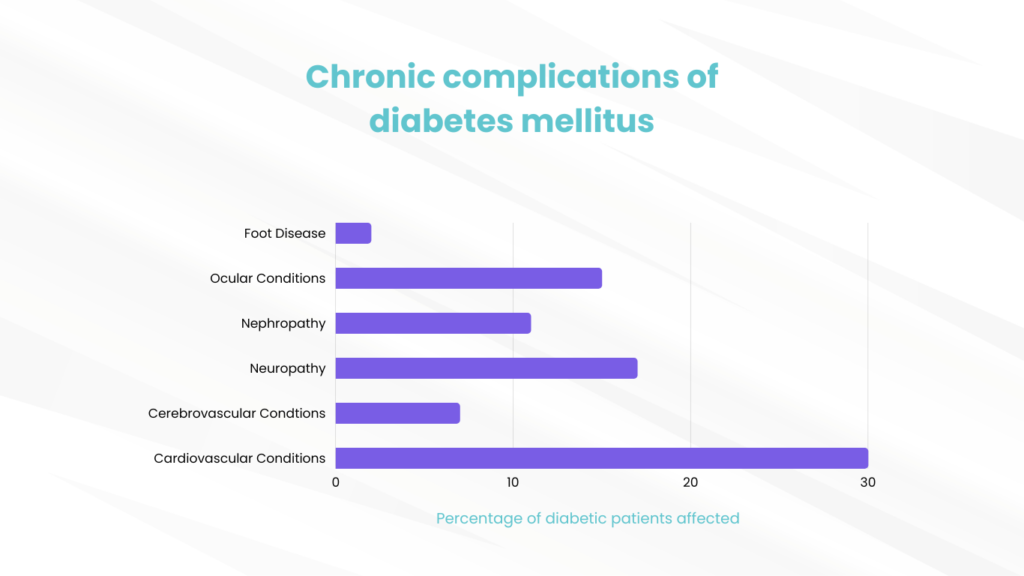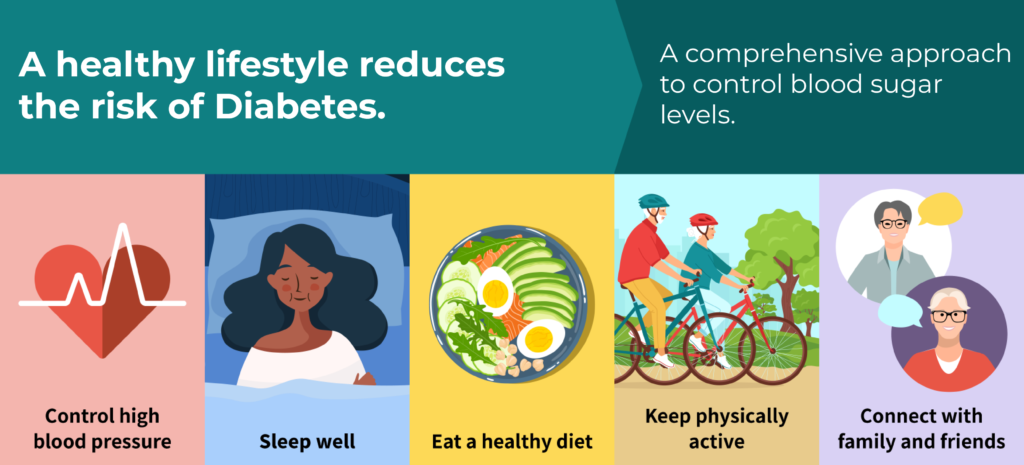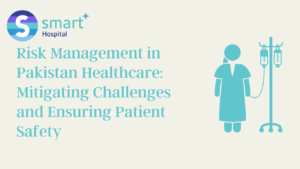Diabetes is a prevalent condition impacting individuals across all age groups. The disease manifests in various forms, with Type 2 being the most common.
A combination of different treatment approaches enables effective management of the disease, fostering a healthy life whilst preventing complications.
What is Diabetes?
Diabetes is like a stubborn, uninvited guest in our body who loves to consume sweets but then can’t handle the excessive amount of sugar.
It is a chronic condition where our body is unable to efficiently process the sugar—glucose—from the food we consume due to inadequate or ineffective insulin production.
Insulin is a hormone that regulates blood sugar. Elevated blood sugar levels over time can lead to serious damage to many body systems.
Types of Diabetes
According to the International Diabetes Federation’s data for 2021, around 26.7% of adults in Pakistan are suffering from diabetes, resulting in an estimated total of approximately 33,000,000 cases.
There are several types of diabetes. The most common forms include:
1. Type 1 Diabetes
Type 1 Diabetes, often diagnosed in children and young adults, is a condition where the body does not produce insulin. Individuals with this type must take artificial insulin daily to stay alive.
2. Type 2 Diabetes
Type 2 Diabetes is far more common and occurs when your body becomes resistant to insulin or doesn’t produce enough. It’s more prevalent in adults but can occur at any age.
3. Gestational Diabetes
Gestational Diabetes appears in some women during pregnancy and usually disappears after the birth of the baby. However, these women and their offspring have a greater risk of developing type 2 diabetes later in life.

Symptoms & Causes
identifying the symptoms of diabetes is crucial for early detection and treatment.
Common signs include:
- Increased thirst and urination
- Extreme hunger
- Unexplained weight loss
- The presence of ketones in the urine
- Fatigue
- Irritability
- Blurred vision
- Slow-healing sores
- Frequent infections
What causes diabetes?
Having an excessive amount of glucose in your bloodstream can lead to diabetes, regardless of the specific type. However, the underlying reasons for high blood glucose levels differ depending on the type of diabetes.
The causes of diabetes include:
1. Insulin Resistance: Type 2 diabetes primarily arises from a condition called insulin resistance. Insulin resistance occurs when cells in your muscles, fat tissue, and liver do not respond properly to insulin.
Various factors and circumstances contribute to varying degrees of insulin resistance, such as obesity, a sedentary lifestyle, dietary choices, hormonal imbalances, genetic factors, and specific medications.
2. Autoimmune Disease: Type 1 diabetes and Latent Autoimmune Diabetes in Adults (LADA) occur when your immune system attacks the insulin-producing cells in your pancreas.
3. Hormonal Imbalances: During pregnancy, the placenta releases hormones that can induce insulin resistance. If your pancreas cannot produce sufficient insulin to counteract this resistance, you may develop gestational diabetes.
Other hormone-related conditions, like acromegaly and Cushing syndrome, can also lead to Type 2 diabetes.

4. Pancreatic Damage: Physical damage to your pancreas resulting from a medical condition, surgery, or injury can affect its ability to produce insulin, leading to Type 3c diabetes.
5. Genetic Mutations: Certain genetic mutations can give rise to Maturity-Onset Diabetes of the Young (MODY) and neonatal diabetes.
Diagnosis and Tests
How is diabetes diagnosed?
Diabetes is typically diagnosed through various tests that measure the levels of glucose (sugar) in your blood. Here are the standard methods for diagnosing diabetes:
1. Fasting Blood Sugar Test
Procedure: Blood is drawn after an overnight fast.
Results:
- Normal: Below 6.1 mmol/L.
- Prediabetes (Impaired Fasting Glucose): 6.1 to 6.9 mmol/L.
- Diabetes: 7.0 mmol/L or higher.
2. Oral Glucose Tolerance Test (OGTT)
Procedure: Blood is drawn after fasting, then you’re given a sugary drink, and blood is drawn again two hours later.
Results:
- Normal: Below 7.8 mmol/L.
- Prediabetes (Impaired Glucose Tolerance): 7.8 to 11.0 mmol/L.
- Diabetes: 11.1 mmol/L or higher.
3. HbA1c Test
Procedure: This test doesn’t require fasting and can be conducted at any time. It measures the average blood sugar level over the past two to three months.
Results:
- Normal: Below 42 mmol/mol (6.0%).
- Prediabetes: 42 to 47 mmol/mol (6.0% to 6.4%).
- Diabetes: 48 mmol/mol (6.5%) or higher.
4. Random Blood Sugar Test
Procedure: Blood is drawn at any time, regardless of when you last ate.
Results: A level of 11.1 mmol/L or higher suggests diabetes.
Special Cases
Pregnant Women: Gestational diabetes is usually diagnosed with an OGTT during the 24th to 28th weeks of pregnancy.
Children and Adolescents: Type 1 diabetes is often diagnosed more quickly, sometimes through urine tests that detect ketones as well as blood tests.
Management & Treatment
Diabetes management and treatment involve a comprehensive approach to controlling blood sugar levels, preventing complications, and enhancing the quality of life.
How is diabetes managed?
The following measures are important in diabetes management:
Lifestyle Changes

- Healthy Eating: Adopt a balanced, nutritious diet. Include plenty of fruits, vegetables, lean proteins, and whole grains while limiting refined sugars and fats.
- Physical Activity: Engage in regular exercise, like walking, jogging, swimming, or cycling to maintain a healthy weight and improve insulin sensitivity.
- Maintain Healthy Weight: Weight management is crucial. Losing even a small amount of weight can make a significant difference.
Medication Management
- Insulin: Some people require insulin injections or insulin pumps to regulate blood sugar levels.
- Oral Medications: There are various types of oral diabetes medications, each working in different ways to lower blood glucose.
Monitoring
Blood Glucose Monitoring: Regularly check blood sugar levels to ensure they are within the target range set by your healthcare provider.
A1C Tests: This test provides information on your average blood sugar levels over the past 2-3 months.
Stress Management
Stress can adversely affect blood sugar levels. Practice relaxation techniques like meditation, yoga, or deep breathing exercises to manage stress effectively.
Regular Medical Check-ups
Eye Exams: Diabetic retinopathy is a common complication; regular eye exams are crucial.
Foot Care: Diabetes can lead to foot problems. Inspect your feet daily for cuts, blisters, red spots, and swelling.
Kidney Function Tests: Diabetes can affect kidney function, making regular testing important.
Takeaway
Finding out you have diabetes changes your life, but you can still live a happy and healthy life. It might feel overwhelming at first, but you’ll soon get the hang of looking after yourself and understanding your body.
Always check in with your doctor. Remember, dealing with diabetes is a team game – you, your doctors, friends, and family are all in this together. If you ever need help, do not shy away from asking them.
References:




